Light Rail Transit (Singapore)
-NfGQ6qLPTtFaOdRbRto4BLnX7cB5ZZ)
Light Rail Transit (Singapore)
-NfGQ6qLPTtFaOdRbRto4BLnX7cB5ZZ)
| Overview | |
|---|---|
| Native name | Sistem Rel Ringan(Malay) 轻轨列车系统(Chinese) இலகு கடவு ரயில்(Tamil) |
| Owner | Land Transport Authority |
| Locale | Singapore |
| Transit type | Automated guideway transit/People mover (APM) |
| Number of lines | 3 |
| Number of stations | 41 (excluding Teck Lee) |
| Daily ridership | 180,000 (2016)[3] |
| Operation | |
| Began operation | 6 November 1999 (1999-11-06) |
| Operator(s) | SBS Transit (ComfortDelGro) SMRT Light Rail (SMRT Corporation) |
| Number of vehicles | 89 trainsets (19 on order, 19 to be decommissioned) |
| Technical | |
| System length | 28.6 km (17.77 mi) |

A diagram of the physical spread of the MRT network across the island, including lines under construction.
The Light Rapid Transit, or Light Rail Transit (LRT), is a series of localised automated guideway transit systems acting as feeder services to the heavy rail Mass Rapid Transit, which together forms the core of Singapore's rail transport services. The first LRT line was opened in 1999 and the system has since expanded to three lines, each serving a public housing estate, namely Bukit Panjang LRT line, Sengkang LRT line and Punggol LRT line. Trains on these lines have at least one station linking it to the MRT and in turn the remainder of the LRT network.
All LRT lines use fully automated and driverless rubber-tired rolling stock closer in size and scope to a people mover system such as those found in many airports around the world. They are elevated and grade-separated in their entireties, and run on viaducts in order to save scarce land space in Singapore. In these respects, the LRT departs from the traditional sense of a light rail system (which are rarely grade-separated and in many cases include street running sections).
Along with the MRT, the LRT is constructed by the Land Transport Authority, with operating concessions currently handed to SMRT Light Rail and SBS Transit.
| Overview | |
|---|---|
| Native name | Sistem Rel Ringan(Malay) 轻轨列车系统(Chinese) இலகு கடவு ரயில்(Tamil) |
| Owner | Land Transport Authority |
| Locale | Singapore |
| Transit type | Automated guideway transit/People mover (APM) |
| Number of lines | 3 |
| Number of stations | 41 (excluding Teck Lee) |
| Daily ridership | 180,000 (2016)[3] |
| Operation | |
| Began operation | 6 November 1999 (1999-11-06) |
| Operator(s) | SBS Transit (ComfortDelGro) SMRT Light Rail (SMRT Corporation) |
| Number of vehicles | 89 trainsets (19 on order, 19 to be decommissioned) |
| Technical | |
| System length | 28.6 km (17.77 mi) |
History
Conception
The concept of having rail lines which could bring people from door to door without requiring the use of road-based buses was much favoured by the government transport planners, especially with the increased emphasis on a rail-based public transport network. For intra-town travel, LRTs were favoured over buses because trains run on dedicated elevated guideways, bypassing any traffic congestion and traffic lights on the roads, and do not add to road traffic. Train arrival and departure times are also almost guaranteed this way. It is also cleaner as the trains are electrically powered, and therefore lessens the effects of air pollution.[4]
Opening of lines
The Bukit Panjang LRT Line opened on 6 November 1999, with all 14 stations opening at the same time. Ten Mile Junction LRT Station was closed from 10 December 2010 till 30 December 2011 for retrofitting works due to the closure and redevelopment of Ten Mile Junction shopping mall (now known as Junction 10), making it the first MRT/LRT station to be completely closed in Singapore after opening. It is the first and only LRT line to be operated by SMRT Light Rail.
The Sengkang LRT Line opened in two main stages, the East Loop opening first on 18 January 2003 and most of the West Loop on 29 January 2005. Farmway LRT Station on the West Loop subsequently opened on 15 November 2007. On 1 January 2013, Cheng Lim LRT Station opened for passenger service and the west loop now operated in a bidirectional way.[5] Kupang LRT Station opened for passenger service on 27 June 2015, marking the completion of the opening of all stations on the Sengkang LRT Line.[6]
For the Punggol LRT Line, the East Loop started operating on the same day as the Sengkang LRT's West Loop, with two stations closed. Oasis LRT Station was opened for service on 15 June 2007, after more residents moved into HDB flats in the station's vicinity.[7] Damai LRT Station opened on 20 June 2011.[8] The West Loop opened on 29 June 2014 at 11.15 am, with Nibong LRT Station, Sumang LRT Station and Soo Teck LRT Station being the first stations to open.[9] Sam Kee LRT Station, Punggol Point LRT Station and Samudera LRT Station opened on 29 February 2016, 29 December 2016 and 31 March 2017 respectively.[10][11]
Teck Lee LRT Station will remain closed until the area around the station has been developed.[10]
Cancelled LRT developments
When the Urban Redevelopment Authority unveiled its early Concept Plans for Singapore's land use during the 1990s, many LRT systems were initially being planned.[4] The government had looked into the feasibility of constructing LRTs to connect nearby towns with one another such as Bedok and Tampines.[4] Others serving Yishun, Buona Vista[12] and some estates within the central region of Singapore had also been proposed. Such possible LRT lines have since been deemed non-viable and rejected due to insufficient demand and high costs incurred by the government.[4][13]
Punggol LRT Line North Branch
A North Branch consisting of two to four LRT stations for the Punggol LRT line had been planned, which would have brought commuters from Punggol LRT Station via Sam Kee and Teck Lee LRT Station before branching out from the West Loop tracks onto this branch, terminating near to Coney Island. The branch was never built, but only visible in the planning stages of Punggol LRT since 2000.[14]
The North Branch was therefore replaced by Punggol Coast MRT station and the bus interchange in 2013[15] which better serve future residents in the area.
Jurong LRT Line
A Jurong LRT line was also proposed in 2001 which would have served the planning areas of Jurong, Boon Lay, Choa Chu Kang, and the future Tengah town. However, the LTA announced in 2008 that there were no plans to develop it.[16] Nonetheless, the LTA later revived the line as the Jurong Region MRT line in the Land Transport Master Plan 2013, and it is set to open in stages from 2026 to 2028.[17][18]
Improvements
Sengkang-Punggol LRT Improvements
On 31 October 2012, LTA announced that by 2016, Sengkang and Punggol LRT systems will be upgraded to a two-car system for 16 of the 41 existing train cars, allowing double the number of passengers to board at any one time. Each train car can take up to 105 passengers. Hence, there is also the need to modify the signaling and communication system.[19]
On 22 December 2015, the two-car trains entered service on the Sengkang LRT line, boosting capacity to 204 per trip as compared to 105 in a single car configuration.[20]
As of 2017, two car trains have entered service on the Punggol LRT line.[10]
On 15 December 2017, the Land Transport Authority said there will be limited services on parts of the Sengkang-Punggol LRT (SPLRT) on most Sundays from 14 January 2018 to 25 February 2018, to facilitate renewal and improvement works from (except 18 February as it is a Chinese New Year holiday). Only one platform will open for service at 5.30am on Sundays. The other platform will open from 7am.[21][22][23] The arrangement is expected to continue until 29 April 2018.[24][25]
On 14 February 2018, the LTA announced that it has taken over SBS Transit's rail assets (the North East MRT line and Sengkang-Punggol LRT lines) worth $30.8 million and transit to the New Rail Financing Framework on 1 April 2018.[26] The LTA has also said that this will benefit commuters as there will be "more coordinated and timely expansion, and renewal of the rail system".[27]
Bukit Panjang LRT Improvements
For the Bukit Panjang LRT Line, SMRT and LTA announced for plans to completely overhaul the BPLRT system as the system is reaching its lifespan of 20 years.[30] Transport Minister Khaw Boon Wan has also announced plans to shut the Bukit Panjang LRT down for a small number of years to pave the way for the system's overhaul.[31] On 23 October 2017, SMRT announced that the Bukit Panjang Light Rail Transit (BPLRT) system will begin operations at 7 am, instead of 5.30am, on all Sundays from 12 November 2017 until the end of the year, to allow more time for works to improve service reliability.[32]
On 13 January 2019, Ten Mile Junction served its last passengers and closed on the next day, 14 January 2019. It also ended Bukit Panjang LRT Service C. Then, Ten Mile Junction was converted into Ten Mile Junction LRT Depot.
Infrastructure
Network
| Line and livery | Opening year | Terminal | Stations | Length (km) | Depot | Electrification | |
|---|---|---|---|---|---|---|---|
| SMRT Light Rail | |||||||
| Bukit Panjang LRT | 1999 | Choa Chu Kang | 13 | 7.6 | Ten Mile Junction Depot | AC 3-Phase 600 V | |
| SBS Transit | |||||||
| Sengkang LRT | 2003 | Sengkang (East Loop) | 5 | 10.7 | Sengkang Depot | DC 750 V | |
| 2005 | Sengkang (West Loop) | 8 | |||||
| Punggol LRT | 2005 | Punggol (East Loop) | 7 | 10.3 | |||
| 2014 | Punggol (West Loop) | 6a | |||||
| a – excluding Teck Lee which is not operational. | |||||||
| Total: | **41** | 28.6 | |||||
Facilities
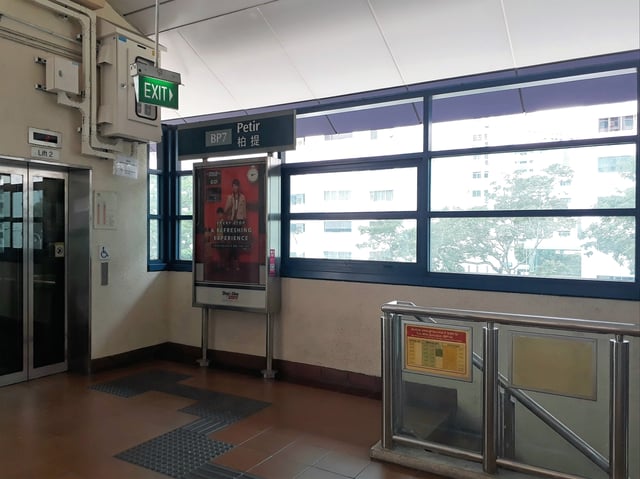
A lift at Petir LRT station.
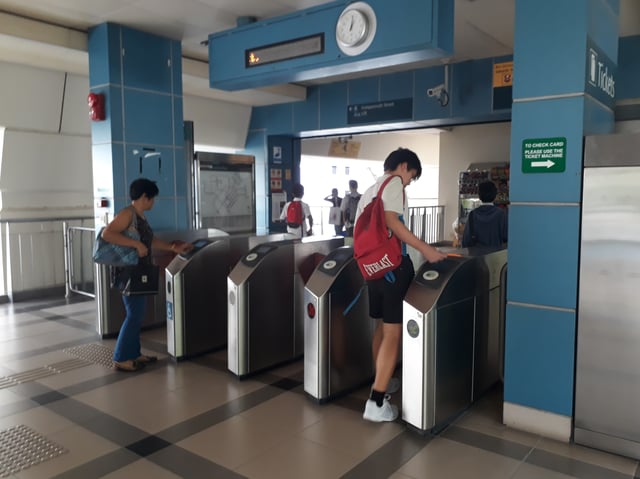
Fare gates at Compassvale LRT station.
Since the LRT system was built in the 1990s, plans for barrier-free facilities have already been included during the planning stages. All 43 stations are equipped with such facilities, thus there will be no difficulties present for the old and handicapped. Barrier-free facilities include lifts, ramps, tactile guidance system and toilets with handicapped-friendly facilities; all stations include wide faregates. These barrier-free facilities will be included in all future LRT stations.[38]
Lines
Bukit Panjang LRT (BPLRT)
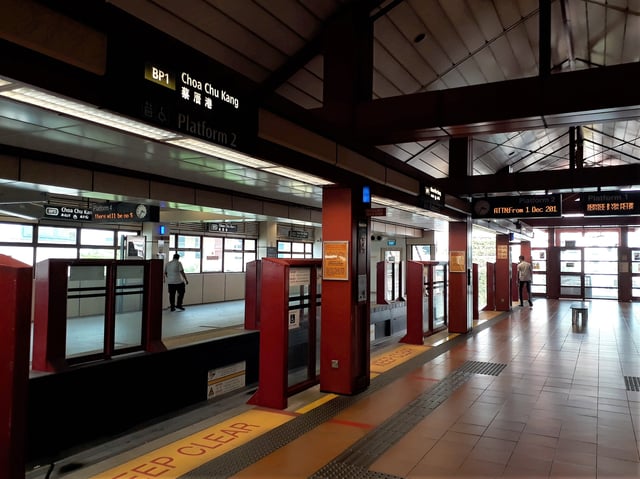
Choa Chu Kang LRT Station, one of the stations on the BPLRT.
The Bukit Panjang LRT Line (BPLRT) is the first light rail line in Singapore. Spanning 7.6 km and consisting of 13 stations, the entire line opened in 1999 and is the first and only LRT line to be operated by SMRT Trains.[39]
Sengkang LRT (SKLRT)
The Sengkang LRT (SKLRT) is a 10.7 km light rail line which partially opened on 18 January 2003. It is part of the LRT system together with the other two lines. The East Loop has 5 stations, all operational, from Compassvale to Ranggung whereas the West Loop has 8 stations from Cheng Lim to Renjong. On 27 June 2015, Kupang opened, making it the last station on the Sengkang LRT to be opened. The completion of several new residential developments in the area deemed it suitable to operate after 12 years.[40]
For a comparison, Cheng Lim opened for passenger service on 1 January 2013 while Farmway opened for passenger service on 15 November 2007 while the rest of the West Loop stations opened for passenger service on 29 January 2005.
Punggol LRT (PGLRT)
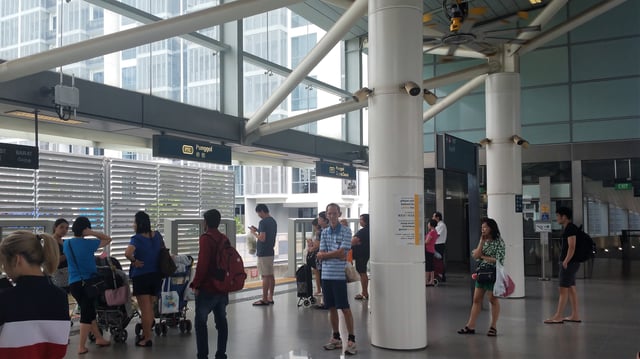
Punggol LRT station, one of the stations on the PGLRT.
The Punggol LRT (PGLRT) is a light rail line in Singapore within the LRT system together with the other two lines. Its first phase, which comprises a 10.3 km light rail line with 15 stations, began operating on 29 January 2005 (with the exception of Oasis, which was opened on 15 June 2007 and Damai, which was opened on 20 June 2011) whereas Nibong, Sumang and Soo Teck were opened on 29 June 2014, the rest of the stations are not opened as Punggol was halfway developed. Subsequently, Sam Kee opened on 29 February 2016, Punggol Point opened on 29 December 2016 while Samudera opened on 31 March 2017 as the area around the stations became more developed. Teck Lee will be opening in tandem with the developments around the area.
Rolling stock

A new Bombardier INNOVIA APM 100 running on the guiderails, in SMRT new livery.
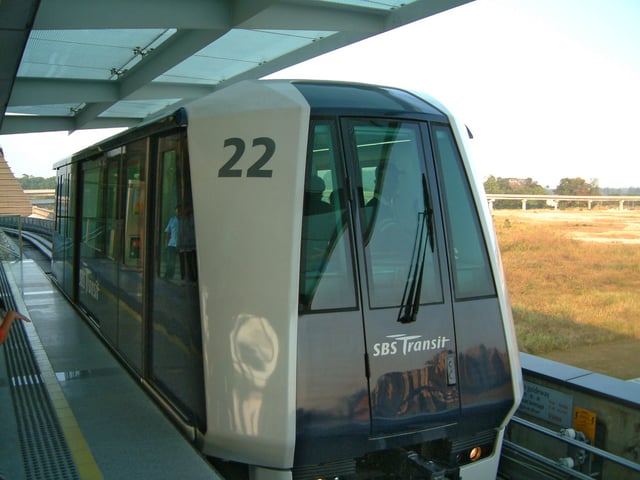
A Crystal Mover on the Punggol LRT system at Punggol LRT station in Singapore.
| Line | Name | No. of Trains | Service Start | Speed Limit |
|---|---|---|---|---|
| Bukit Panjang LRT | Bombardier Innovia C801 | 19 | 1999 | 48 km/h |
| Bombardier Innovia C801A | 13 | 2014 | ||
| Sengkang-Punggol LRT | Mitsubishi Crystal Mover C810 | 41 | 2003 | 70 km/h |
| Mitsubishi Crystal Mover C810A | 16 | 2016 |
The trains on the LRT system are fitted with rubber tyres, rather than steel wheels, on specially-constructed guideways from which its power is also sourced. All cars are fully automated and driverless, and are controlled from their respective depots.
Rolling stock that is on the Light Rail Transit are also used on the Changi Airport Skytrain, where the only change is in 2006 from the Bombardier C-100 to Mitsubishi Crystal Mover.
Little is known regarding the fate of the older Bombardier C-100s that was built in 1990 for the Changi Airport Skytrain.
Signalling
All Light Rail Lines are able to run automatically, are fully driverless and automated. The following list documents the systems:
Depots
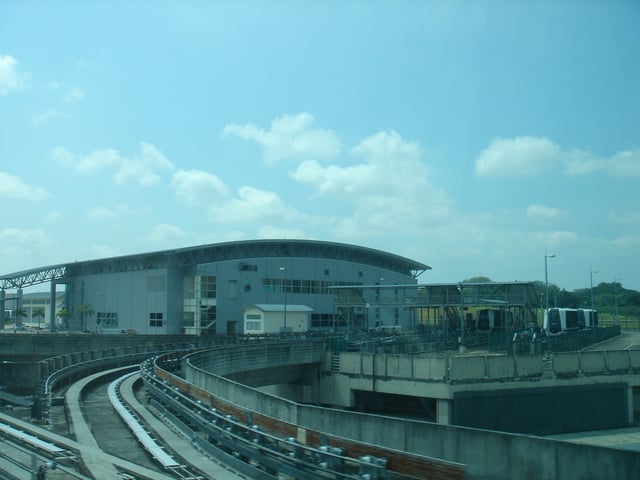
LRT trains are parked at the top level of Sengkang Depot.

Panoramic view showing the Sengkang LRT Line (SKLRT). Renjong LRT station lies to the left, and the Sengkang Depot for North East Line and SKLRT to the right. In the distant background lie Buangkok and Hougang.
The LRT system consists of two depots, which run the maintenance, inspection, train overhaul facilities, and house the cars overnight. The Ten Mile Junction Depot houses cars for Bukit Panjang LRT, and the Sengkang Depot houses cars for the Sengkang LRT and Punggol LRT, together with the North East Line of the Mass Rapid Transit (MRT).
Fares and ticketing
The Light Rail Transit uses the same ticketing system as the Mass Rapid Transit. It uses the contactless EZ-Link smart card and a standard single trip ticket.
Instead of using turnstile faregates, all stations on the Bukit Panjang LRT Line now use retractable faregates instead which is faster and easier and the replacement was completed in 2017.
Safety
By 2018, glass and steel platform barriers will be installed at all 43 LRT stations to prevent people from falling onto the tracks. Unlike the ones in overground MRT stations, the LRT structures will not have sliding doors but fixed openings. The barriers have been erected at Choa Chu Kang and Bukit Panjang LRT stations in anticipation of higher commuter traffic with the opening of Downtown Line 2. This will be followed by the rest of the stations on the Bukit Panjang and Sengkang-Punggol LRT lines by 2018.[41]
The installation of these barriers was completed at all LRT stations in 2017.[42]
See also
List of Singapore LRT stations
Mass Rapid Transit
Transport in Singapore
Rail transport in Singapore